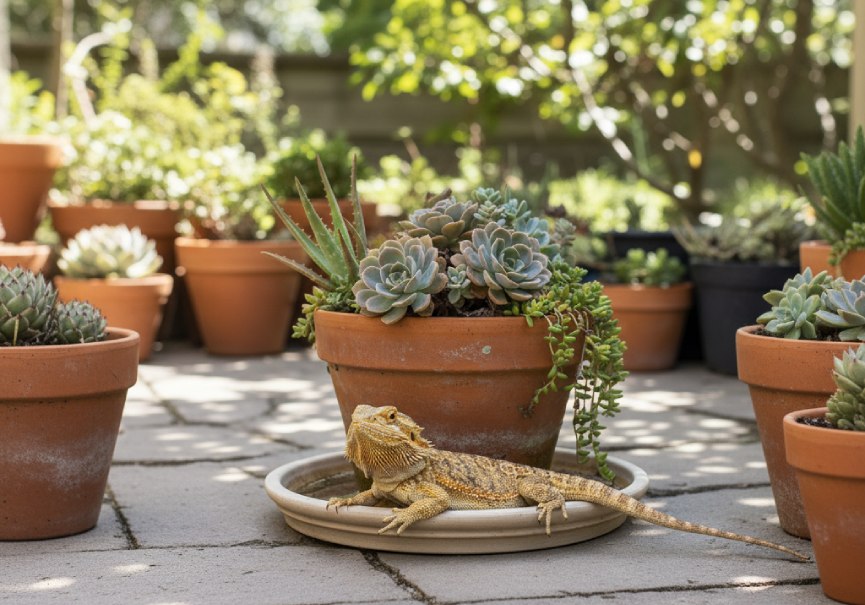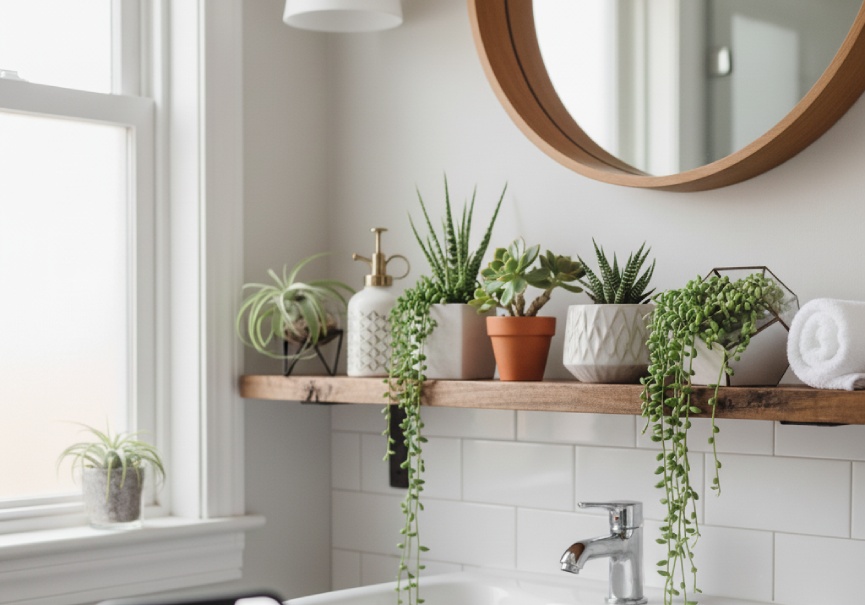Can Bearded Dragons Eat Succulents? The Ultimate Guide to Safe and Unsafe Plants

Introduction
Bearded dragons are curious, intelligent reptiles that thrive when given proper nutrition and a stimulating environment. Many owners like decorating their terrariums to resemble natural desert surroundings, often including live plants. This leads to an important question:
Can bearded dragons eat succulents?
Succulents are popular for their unique look and hardy nature. However, not all succulents are safe. Some are harmless and can be offered occasionally, while others contain toxins that can cause serious harm.
This guide will cover:
- Safe succulents for bearded dragons
- Toxic succulents to avoid
- Feeding rules and precautions
- How to protect both your beardie and your plants
- Signs of poisoning and emergency steps
Let us explore everything you need to know to keep your bearded dragon healthy while enjoying a beautifully decorated habitat.
Do Bearded Dragons Eat Succulents in Nature?
In the wild, bearded dragons live in dry, rocky regions of Australia. They eat a variety of foods such as:
- Insects
- Leafy plants
- Flowers
- Occasional fruits
- Small animals on rare occasions
Succulents are not a major part of their natural diet. While they might occasionally encounter similar plant types, their bodies are not adapted to consume large quantities of water-filled, low-nutrient plants.
Natural Diet Breakdown
| Food Type | Adult Diet % | Juvenile Diet % |
|---|---|---|
| Protein and insects | 20 to 30 percent | 70 to 80 percent |
| Leafy greens and vegetables | 70 to 80 percent | 20 to 30 percent |
| Fruit | Rare treat | Very rare treat |
Succulents are not required and should only be a tiny part of the diet if used at all.
Can Bearded Dragons Eat Succulents?
Short answer:
Some succulents are safe in small amounts. Many are toxic.
Even the safe ones should only be offered:
- Occasionally
- In very small pieces
- Fully washed and pesticide-free
Succulents are better as enclosure décor than regular food.
Safe Succulents for Bearded Dragons
Below are succulents generally considered safe when offered sparingly.
Sempervivum (Hens and Chicks)
Non-toxic, safe as an occasional nibble.
Sedum (Certain Varieties)
Safe in very small portions. Avoid unknown species.
Prickly Pear Cactus (Opuntia)
One of the safest options. Remove all spines and glochids before offering.
Echeveria
Soft-leafed and generally safe in small quantities.
Aloe Vera
Edible but can act as a laxative. Very small portions only.
Some Varieties of Kalanchoe
Caution is needed because many Kalanchoe species are toxic. Only offer verified safe species.
Burro’s Tail (Sedum morganianum)
Mild and generally safe in tiny pieces.
Christmas Cactus (Schlumbergera)
Non-toxic, safe in moderation.
Ghost Plant (Graptopetalum paraguayense)
Safe but not nutritious.
Haworthia
Safe succulents are often used in reptile tanks as decoration more than food.
Toxic Succulents to Avoid
These plants contain harmful compounds and should never be eaten or placed within reach.
| Plant | Risk |
|---|---|
| Jade Plant (Crassula ovata) | Poisonous |
| Pencil Cactus (Euphorbia tirucalli) | Irritating sap, harmful if eaten |
| Crown of Thorns (Euphorbia milii) | Toxic latex sap |
| Snake Plant (Sansevieria) | Toxic to reptiles |
| Aeonium | Harmful compounds |
| Mother of Thousands (Bryophyllum) | Highly toxic |
| String of Pearls (Senecio rowleyanus) | Dangerous if ingested |
| Panda Plant (Kalanchoe tomentosa) | Toxic |
| Euphorbia species | Highly irritating and toxic |
| Kalanchoe daigremontiana | Very toxic |
When uncertain, assume the plant is not safe.
Symptoms of Plant Toxicity
If your bearded dragon consumes a toxic plant, watch for:
- Weakness or lethargy
- Vomiting
- Diarrhea
- Loss of appetite
- Swollen tongue or mouth
- Difficulty breathing
- Shaking or trembling
- Stress darkening of the beard
Seek veterinary help immediately if symptoms appear.
How to Protect Succulents From Bearded Dragons
Even safe plants can be destroyed quickly by curious reptiles. These tips help keep your plants intact:
- Place plants on shelves or raised stands
- Use hanging planters
- Keep live plants in a separate section of the room
- Supervise out-of-tank exploration
- Offer greens daily so the dragon is less tempted
- Consider artificial succulents for the enclosure
How to Protect Bearded Dragons From Toxic Succulents
Safety should always be the priority. Follow these steps:
- Educate yourself on safe and toxic plants
- Keep harmful plants out of the home or out of reach
- Ensure the terrarium is escape-proof
- Provide a complete diet so they do not forage
- Monitor interactions with plants
- Contact a reptile veterinarian if accidental ingestion happens
Feeding Guidelines for Succulents
| Stage | Frequency | Portion |
|---|---|---|
| Hatchlings and juveniles | Not recommended | Avoid |
| Adult dragons | Rare treat | 1 to 2 small bites occasionally |
Succulents should never replace vegetables or leafy greens.
Better Food Alternatives
Offer these nutritious greens instead:
- Collard greens
- Dandelion greens
- Mustard greens
- Endive
- Turnip greens
- Squash
- Safe herbs like basil or cilantro in moderation
- Hibiscus leaves and flowers
These provide much better nutrition than succulents.
Conclusion
Can bearded dragons eat succulents? Yes, but only certain types and only in very small amounts. Many succulents are toxic and should be avoided entirely.
To keep your bearded dragon healthy and happy:
- Use safe succulents sparingly as treats
- Avoid toxic species
- Prioritize leafy greens and insects
- Monitor any contact with live plants
- Seek vet help if toxicity is suspected
A well-fed, well-cared-for bearded dragon is less likely to chew on plants anyway.
FAQs
1. Can bearded dragons eat succulents? Ans:- Only some types and only in small amounts.
2. What succulents are safe? Ans:- Examples include Sempervivum, Echeveria, Haworthia, and Prickly Pear cactus.
3. What succulents are toxic? Ans:- Jade plant, Euphorbia species, Snake plant, Mother of Thousands, and others.
4. Should succulents be part of the regular diet? Ans:- No. They are not nutritionally necessary.
5. Can succulents be used in tanks? Ans:- Yes, as long as they are safe and monitored.
6. What should I do if my dragon eats a toxic plant? Ans:- Contact a reptile veterinarian immediately.






